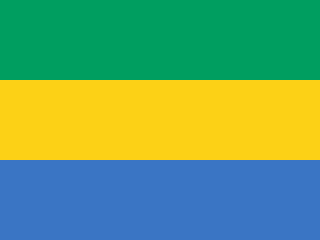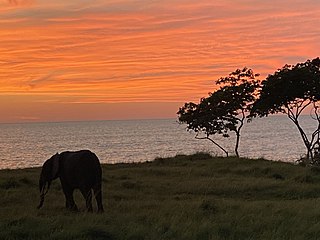Related Research Articles

Gabon, officially the Gabonese Republic, is a country on the west coast of Central Africa. Located on the equator, Gabon is bordered by Equatorial Guinea to the northwest, Cameroon to the north, the Republic of the Congo on the east and south, and the Gulf of Guinea to the west. It has an area of nearly 270,000 square kilometres (100,000 sq mi) and its population is estimated at 2.1 million people. There are three distinct regions: the coastal plains, the mountains, and the savanna in the east. Gabon's capital and largest city is Libreville. The official language is French.

Little is known of the history of Gabon prior to European contact. Bantu migrants settled the area beginning in the 14th century. Portuguese explorers and traders arrived in the area in the late 15th century. The coast subsequently became a center of the transatlantic slave trade with European slave traders arriving to the region in the 16th century. In 1839 and 1841, France established a protectorate over the coast. In 1849, captives released from a captured slave ship founded Libreville. In 1862–1887, France expanded its control including the interior of the state, and took full sovereignty. In 1910 Gabon became part of French Equatorial Africa and in 1960, Gabon became independent.

Gabon's music includes several folk styles and pop. Gabonese pop artist Patience Dabany, who now lives in the US, produces albums recorded in Los Angeles with a distinctively Gabonese element; they are popular throughout Francophone Africa. Other musicians include guitarists Georges Oyendze, La Rose Mbadou and Sylvain Avara, and the singer Oliver N'Goma. Imported rock and hip hop from the US and UK are popular in Gabon, as are rumba, makossa and soukous.

French is the official language in Gabon, however 32% of the people speak Fang as a mother tongue. French is the medium of instruction. Before World War II very few Gabonese learned French, nearly all of them working in either business or government administration. After the war, France worked for universal primary education in Gabon, and by the 1960-61 census, 47% of the Gabonese over the age of 14 spoke some French, while 13% were literate in the language. By the 1990s, the literacy rate had risen to about 60%.
Oliver N'Goma was a Gabonese afro-zouk and soukous singer and guitarist. He was born in Mayumba in south-west Gabon in 1959. He is best known for his 1989 song Bane, which was popularized by Radio Africa N.1 and Gilles Obringer.
Cape Verdeans in Canada are Canadian residents whose ancestry originated in Cape Verde.
Cape Verdean Argentines are Argentine residents whose ancestry originated in Cape Verde. According to the 1980 census, there were about 8,000; but today's population was estimated by some sources to be around 2,000 in 2007. Other sources estimate that in 2006 there were 12,000-15,000 descendants of immigrants from Cape Verde living in Argentina, of whom about 300 are native to the African continent.
Cape Verdean Mozambican are Mozambican residents whose ancestry originated in Cape Verde.
Cape Verdeans in France are residents of France who are from Cape Verde or have Cape Verdean ancestry.
In 1995, it was estimated that there were 50,000 people of Cape Verdean descent or national origin in Portugal. By 2000, this estimation rose to 83,000 people, of which 90% resided in Greater Lisbon." In 2008, Portugal’s National Statistics Institute estimated that there were 68,145 Cape Verdeans who legally resided in Portugal. This made up "15.7% of all foreign nationals living legally in the country."
Cape Verdeans in Luxembourg are Luxembourg residents whose ancestry originated in Cape Verde.
Cape Verdeans in Sweden are citizens and residents of Sweden who are of Cape Verden descent. In 1995, it was estimated that there were 3,000 people of Cape Verdean descent in Scandinavia. One of the most famous Swedes of Cape Verdean descent is footballer Henrik Larsson, who was born to a Cape Verdean father and a Swedish mother, his son Jordan Larsson is also now a full Swedish international after being born in Rotterdam, in the Netherlands.
Cape Verdean Angolan are Angolan residents whose ancestry originated in Cape Verde.
The presence of Cape Verdeans in Italy dates back to the 1960s.
Cape Verdean Spaniards are residents of Spain whose ancestry originated in Cape Verde.
The Cabo Verdean diaspora refers to both historical and present emigration from Cape Verde. Today, more Cabo Verdeans live abroad than in Cape Verde itself. The country with the largest number of Cape Verdeans living abroad is the United States.
Cape Verdean Ivorian are Ivorian residents whose ancestry originated in Cape Verde.
Cape Verdeans, also called Cabo Verdeans, are the citizens of Cape Verde, an island nation in West Africa consisting of an archipelago in the central Atlantic Ocean. Cape Verde is a sociedade mestiça, which means that it is home to mixed-race people, whose ethnogenesis is in Cape Verde, which has no indigenous population.
The African nation of Gabon has had human inhabitants for perhaps 400,000 years. Bantu peoples settled here from the 11th century. The coastline first became known to Europeans through Portuguese and Dutch sailors. Colonised by the French in the 19th century, Gabon became independent in 1960.
References
- ↑ 1995 Cape Verdean Diaspora Population Estimates Archived 2009-08-29 at the Wayback Machine